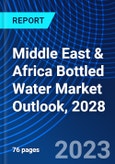This report comes with 10% free customization, enabling you to add data that meets your specific business needs.
1h Free Analyst TimeSpeak directly to the analyst to clarify any post sales queries you may have.
According to the research report Middle East and Africa Bottled Water Market Outlook, 2028, the Middle East and Africa Bottled Water market is anticipated to reach a USD 23.13 billion market size by the end of the forecast period. Growing awareness of the importance of hydration and healthy lifestyles has fueled the demand for bottled water in the MEA region. Consumers are actively seeking alternatives to sugary beverages and opting for bottled water as a healthier choice. The MEA region is witnessing advancements in distribution channels for bottled water. Bottled water companies in the MEA region are exploring untapped markets and expanding their presence beyond major urban areas. This includes targeting rural areas, remote regions, and emerging markets with improved distribution networks and customised offerings. Technological advancements play a role in improving production processes, quality control, and efficiency in the bottled water industry. Water purification technologies, automated production lines, and IoT-enabled monitoring systems contribute to enhancing product quality and operational effectiveness. Based on the product types, there are still water, sparkling water, functional water, and enhanced water. In the Middle East and Africa, Still Water has the highest market share. The MEA region faces water scarcity challenges and limited access to safe drinking water in certain areas. Bottled water provides a convenient and reliable source of clean drinking water, especially in regions where tap water may not be readily available or may not meet quality standards. The MEA region has a rapidly growing population and increasing urbanisation rates. Urban areas, in particular, witness higher demand for bottled water due to factors such as population density, lifestyle changes, and reliance on packaged beverages. The MEA region is known for its hot and arid climate, with high temperatures and low humidity. In such conditions, still water is preferred by consumers for its refreshing and hydrating properties. Still water helps quench thirst effectively and provides essential hydration, making it a popular choice in the region.
Based on the distribution channel, which includes off-trade and on-trade, in Middle East and Africa, the off-trade market has the highest market share. The off-trade segment offers convenience and accessibility to consumers. Supermarkets, hypermarkets, and convenience stores have extensive distribution networks and wide coverage, making it easier for consumers to access bottled water products. Online platforms provide the convenience of doorstep delivery, further enhancing accessibility. The off-trade segment provides a wide range of bottled water brands, types, and packaging options. Consumers can choose from various sizes, formats, and brands, allowing them to select the most suitable bottled water product based on their preferences, budget, and specific requirements. The off-trade segment offers consumers a sense of trust and assurance regarding the quality, safety, and authenticity of bottled water products. Established retail outlets have rigorous quality control measures in place to ensure that the products they sell meet regulatory standards and consumer expectations. There are several hypermarkets and supermarkets that offer bottled water, like Lulu, Carrefour, and Spinneys.
There are several associations for the Middle East and African bottle water market. The International Bottled Water Association (IBWA) is an international trade association that represents the bottled water industry globally. Although it is not specific to the MEA region, it includes members from various countries, including those in the MEA region. The Africa Water Association (AfWA) is a professional association that focuses on water supply, sanitation, and environmental issues in Africa. While it primarily deals with water-related matters in general, it may encompass the bottled water sector as well. The Middle East Water Forum (MEWF) is a platform that brings together water sector professionals, organisations, and experts in the Middle East region. While it covers various aspects of the water industry, it may also address topics related to bottled water. These associations provide platforms for knowledge-sharing, industry networking, advocacy, and best practises within the water sector, including the bottled water industry. There are several opportunities and trends in the bottled water market in the Middle East and Africa. The MEA region has a rapidly growing population coupled with increasing urbanisation. This provides a larger consumer base for bottled water, as urban areas often face challenges with access to clean and safe drinking water. As economies in the MEA region continue to develop, disposable income levels are also increasing. This enables consumers to afford packaged bottled water as a convenient and safe drinking water option. The MEA region attracts a significant number of tourists and has a thriving hospitality industry. The demand for bottled water is high in these sectors as tourists and hotel guests seek reliable and safe drinking water during their travels. Consumers in the MEA region are showing a preference for premium and functional bottled water products. This includes premium natural spring water, enhanced water with added minerals or vitamins, and specialised functional waters like alkaline water or electrolyte-infused water. There is a growing demand for local and regional bottled water brands in the MEA region. Consumers appreciate products that are sourced locally, emphasising their authenticity and supporting local businesses. These opportunities and trends reflect evolving consumer preferences, market dynamics, and sustainability considerations in the Middle East and Africa bottled water markets.
Considered in this report
- Geography: Middle East & Africa
- Historic year: 2017
- Base year: 2022
- Estimated year: 2023
- Forecast year: 2028
Aspects covered in this report
- Middle East & Africa Bottled Water market with its value and forecast along with its segments
- Country-wise Bottled Water market analysis
- Various drivers and challenges
- On-going trends and developments
- Top profiled companies
- Strategic recommendation
Countries covered in the report:
- UAE
- Saudi Arabia
- South Africa
By Products Type
- Still Water
- Sparkling Water
- Functional Water
- Enhanced Water
By Distribution Channel
- Off-Trade
- On-Trade








